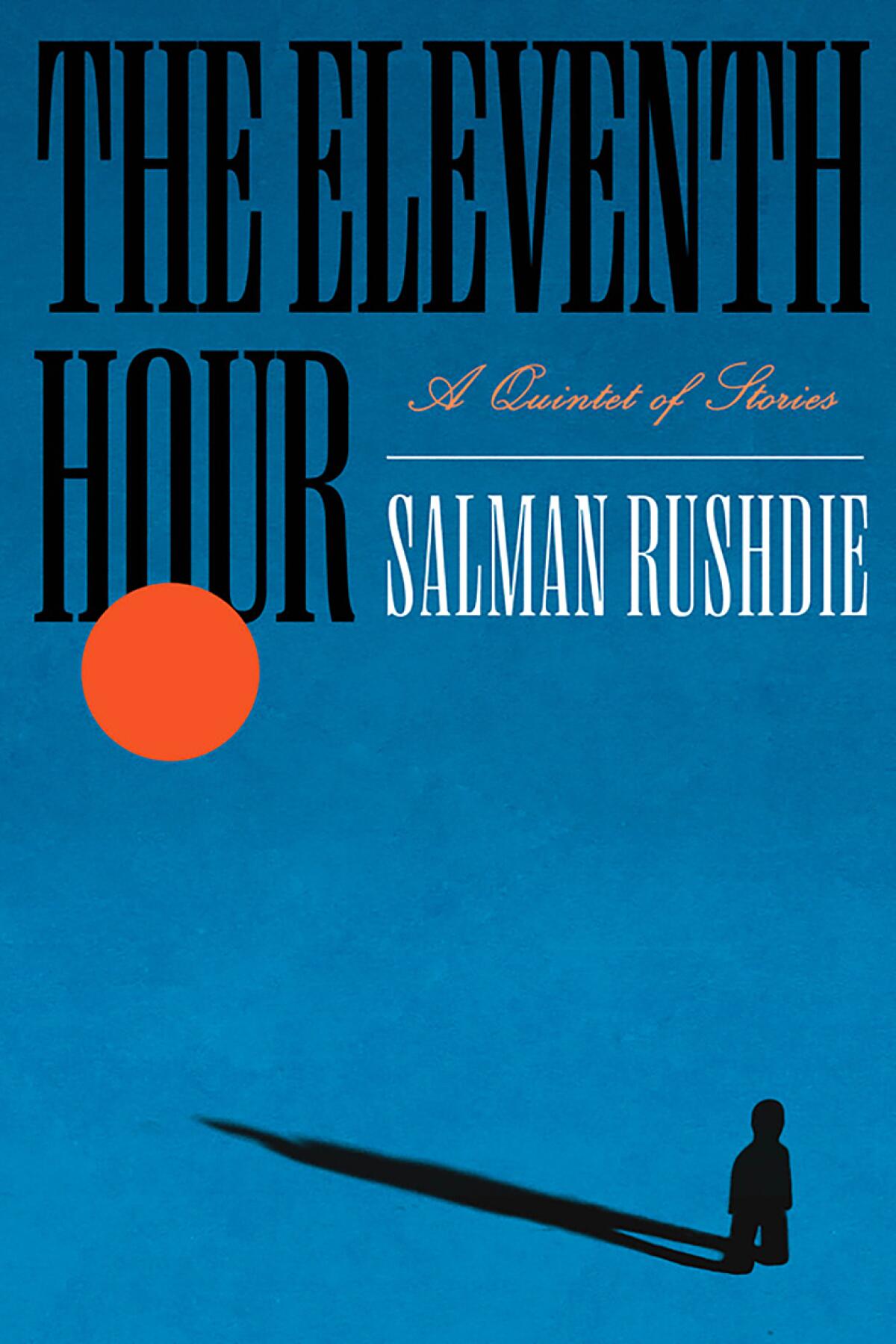Salman Rushdie discusses his new book ‘The Eleventh Hour’
On Aug. 12, 2022, Salman Rushdie was stabbed 15 times just as he was about to give a public lecture at the Chautauqua Institution in New York. Gravely wounded, Rushdie lost sight in his right eye. The following spring, he published “Knife: Meditations After an Attempted Murder,” which became a bestseller. His new book, “The Eleventh Hour: A Quintet of Stories,” is his first work of fiction since the attack that nearly killed him.
A showcase for his dynamic range, the book careens from social critique to ghost stories and dream-like fables. On a recent Zoom call, the writer discussed the consolations of fiction, Franz Kafka and the moral rot of the gilded class.
✍️ Author Chat
This is the first fiction you’ve written since “Knife.” How did you get that part of your creative brain going again?
I’m so happy to have fiction to talk about again! The attack kind of stopped the fiction juices from flowing. It’s as if my mind wouldn’t look back into the world of the imagination. But the moment I finished “Knife,” even before it came out, I was suddenly thinking about fiction again. It was as if by magic, I had to somehow sweep that subject away — out of the front of my mind, into the back of my mind — in order to let other stuff come in.
So you’re thrilled to be writing fiction again.
Yes. Memoir was never a form that attracted me. I don’t particularly want to write about myself.
Were all the stories in the new book written after the knife attack?
The two stores which bookend the collection were written earlier, although I did revise them. The first story I wrote for the book was “Late,” which is the first ghost story I’ve ever written.

“The Eleventh Hour: A Quintet of Stories” by Salman Rushdie.
(Random House)
That is actually astonishing to me. You have had elements of the supernatural and fantasy in your fiction, but not specifically a ghost story?
I’ve had that, but I haven’t had a ghost as a hero. And I must say, it became incredibly enjoyable to write.
I’d always wanted to write something arising out of my time at Cambridge, but I’d never really found a story. Then I had this idea of an encounter between this older academic and this young Indian woman who made friends because of their mutual love of India. When I sat down to write it, I found myself killing him. It took me completely by surprise. And the story became something else entirely.
There is in a few of these stories the character of the old don, the wizened, sage academic. Were these characters based on gray eminences you may have encountered at Cambridge?
I was lucky that my time at King’s College overlapped just a little bit with the great E.M. Forster. He was almost 90 and I was 19, but he was very approachable. He liked students to approach him and have a conversation. He would sometimes come and sit in the student common room with a little glass of beer and a little kind of flat cap. And when he discovered that I had a background in India, he became extra chatty because India had, of course, been unbelievably important to him in his life.
“Oklahoma” is perhaps the most dream-like story in the collection, about a young man searching for an older man, a famous writer, who has disappeared. It’s a dense piece, with a distinct Kafka influence.
There was an extraordinary exhibition at the Morgan Library here in Manhattan, of the manuscripts of Kafka. They had “The Trial,” “The Castle” and “Amerika,” an unfinished novel whose original title was “The Man Who Disappeared.” And that stuck with me. So I found myself writing a story in which Kafka makes a guest appearance, but it’s basically in the end about two men who disappear. “Oklahoma” is taken from “Amerika,” but Kafka never set foot in America, of course. It’s an Oklahoma of the mind and spirit, the place where you find satisfaction and fulfillment.
In “The Musician of Kahani,” about a marriage between a middle-class pianist and wealthy playboy, it feels like you are describing this new class of what you refer to as the “rich-rich,” the new vulgarian wealthy class. In the past, rich people were associated with glamour, but now it feels like a kind of boorish narcissism.
Yes, in the past, there was a kind of Gatsby-level glamour attached to the wealthy. One of the things that used to be the case in India after independence is that Gandhian ideas were very prominent. Indian weddings tended to be quite modest affairs. There was a Gandhian idea that you don’t flaunt your wealth. Well, that’s gone out the window, right? All the Gandhian notions are very much out of favor in India now. This has resulted in fantastically flamboyant weddings. And when you get to this level of the ultra-rich, there is a kind of surrealism on display.
Do you read much contemporary fiction?
I’m a huge admirer of Toni Morrison, if that’s contemporary enough. I’m also very keen on James McBride, especially “The Good Lord Bird” and “The Heaven and Earth Grocery Store,” for the range, the detail and the comedy in his writing, which is profound. I read two 700 page books this summer: Kiran Desai’s “The Loneliness of Sonia and Sunny” — which took her 19 years to write and I think is a kind of masterpiece — and Nicholas Boggs’ biography of James Baldwin, which I loved.
(This Q&A has been edited for length and clarity.)
📰 The Week(s) in Books

“She comes across as preaching to her peers rather than seeking converts,” Hamilton Cain writes of Smith’s new book.
(Jay L. Clendenin / Los Angeles Times)
Patti Smith’s new memoir, “Bread of Angels,” is “mesmerizing,” Leigh Haber writes for The Times. The book “deepens the mystery of who this iconic artist is and where her singular vision originated.”
Susan Straight’s new novel “Sacrament,” about a clutch of ICU nurses battling COVID in a San Bernardino hospital, “broadens the reader’s understanding of community beyond flesh-and-blood friends, family and neighbors,” according to Merdith Maran. “The love and care that flow within her community of characters draws the reader into their bright, tight circle, making the characters’ loved ones and troubles feel like the reader’s own.”
Robert Dowling’s new biography of actor and playwright Sam Shepard “expertly untangles the history of a man who contained multitudes,” writes Mark Athitakis.
Hamilton Cain has mixed emotions about Zadie Smith’s new collection of essays, “Dead and Alive,” writing that “the book’s finest pieces wrangle, in elegant prose, with humanity’s contradictions,” but “the weaker ones indulge in name-dropping, footnotes and op-ed invective.”
📖 Bookstore Faves
In the two years since Zibby Owens opened Zibby’s Bookshop, the Santa Monica store has become a vital hub for booklovers on the Westside who are drawn to the quaint, well-curated selection of books and the numerous events that take place throughout the year. I asked Zibby’s store manager Kartina Leno to tell us what book buyers are scooping up.
What’s selling right now?
Our customers are loving memoirs. “They All Came to Barneys” by Gene Pressman and “I Regret Almost Everything” by Keith McNally are flying off our shelves. By far the biggest fiction seller all year has been “The Wedding People” by Allison Espach. It’s smart, funny, and has a beautiful message.
How does the store foster a community of readers?
Our author events are such a place of community and comradeship to our customers. We have anywhere from three to five per week, and they feel like such a safe and welcoming space. We also offer a once-a-month book club that meets in person and also sees a great turnout. We have people who’ve been coming now for almost three years!
What genres have readers excited right now?
Our customers love a good cozy mystery and we’re still selling tons of “The Thursday Murder Club” by Richard Osman and “Everyone in My Family has Killed Someone” by Benjamin Stevenson. The romantasy bug has also been going around, so we make sure to have plenty of copies of Sarah J. Maas in stock.
Zibby’s Bookshop is at 1113 Montana Ave. in Santa Monica.
(Please note: The Times may earn a commission through links to Bookshop.org, whose fees support independent bookstores.)

